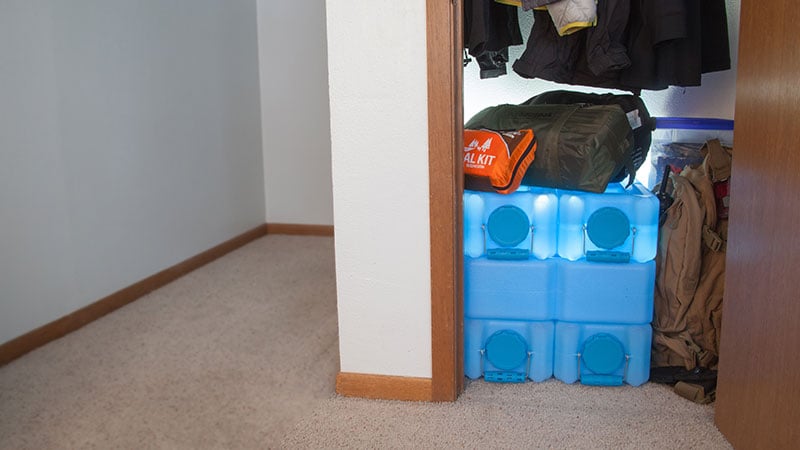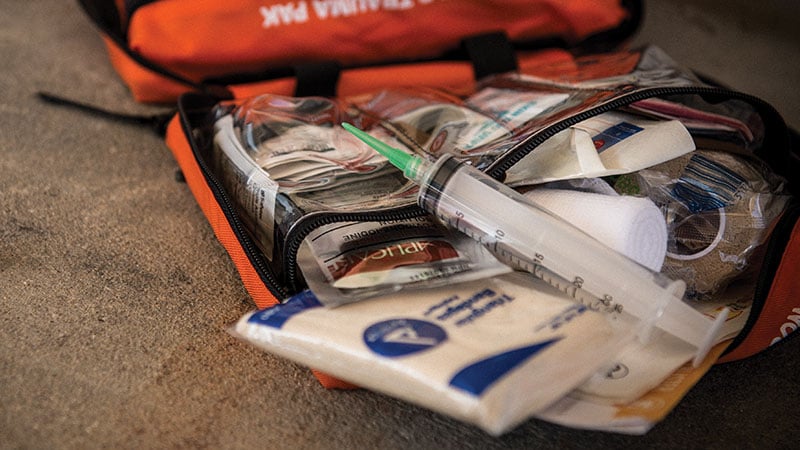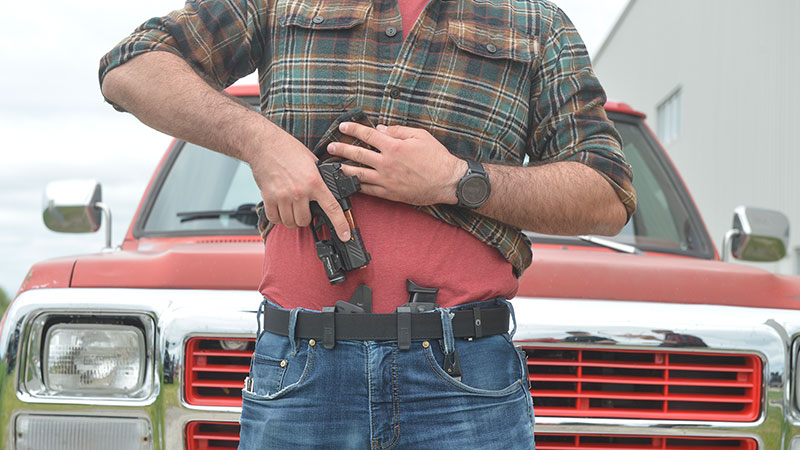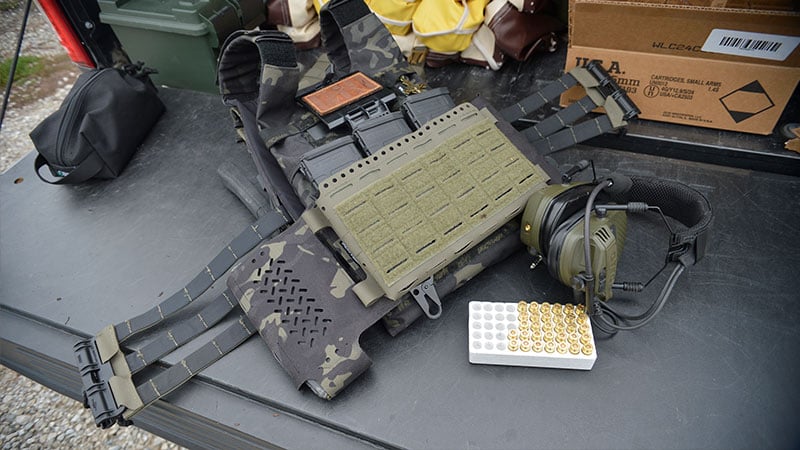Emergency Preparedness 101
Emergency Preparedness 101 Get Ready Before Trouble Starts!
Flood. Tornado. Wildfire. Hurricane. Civil unrest. Earthquake. Emergencies don't phone ahead weeks in advance to warn us they're coming. They often happen unexpectedly, in the middle of our ordinary daily lives. The difference between having a tough time and riding out an emergency in reasonable safety and comfort is being prepared. Stock up on the emergency supplies and resources you'll need to survive a period of time (probably days, maybe weeks) without the modern services and conveniences we all take for granted.
If you don't have electricity or gas service, how will you prepare food? After you use up that small pack of bottled water in the kitchen, how will you stay hydrated? If it's wintertime, how will you stay warm? Not everybody is a Good Samaritan. How will you protect yourself and your family from people who violate the "social contract"? Certainly, firearms should figure into your preparedness plan, but they are only a small part of what you'll need to "live off the grid" until the grid comes back online.
The time to gather supplies and plan how to handle contingencies is BEFORE the emergency happens. We've assembled the following tips to help you do just that.
The Most Critical Resource - Water
Water is absolutely critical for survival. An adult needs one gallon of drinkable water per day, more in hot climates. A person can go approximately three days without water before impairment of physical and mental functions sets in. But going three days without water is a highly unpleasant experience! The clock begins ticking when you run out of safe drinking water. Severe flooding, storms, and civil unrest can strike at any time, or your vehicle can break down and you're simply stranded. You can be caught by surprise without a means of obtaining that necessary one gallon per day of drinking water.

Your health and survival will begin evaporating even faster if you ingest even a few drops of contaminated water. Almost no natural source of water in the world is free of contamination, even the clearest, coolest mountain stream. These contaminants include the protozoans (single-celled organisms) and cysts - nasty intestinal parasites such as E Coli, Giardia, and Cryptosporidium. Getting infected with any of these is no joke, and some of these sicknesses come on fast and incapacitate you quickly, greatly diminishing your chances of survival. The tried-and- true method of purifying water is to boil it. Various filters and water purification products are also available.
The one surefire way to be sure you have an adequate supply of safe, pure, drinking water is to stock it up ahead of time. Blue Can Water is what its name implies: purified drinking water in sealed aluminum cans with a 50-year shelf life. You can store up ordinary bottled water from the local big box store, too, but remember what we said at the beginning - emergencies happen when you least expect them. Another method is to store up drinking water in dedicated storage containers, such as the modular Waterbrick system.
Food - The Other Necessity
Food is actually not as big of a survival priority as you might think, because a person can go approximately three weeks without food. But again, going without food that long is not a happy experience! To avoid that, FEMA recommends everybody store at least a three-day supply of non-perishable food in case of emergencies that disrupt the normal food supply chain. Plenty of foods available at your local supermarket fill the bill: ready-to-eat canned meats, fruits, vegetables, milk, and juices, as well as dry cereal, protein or fruit bars, peanut butter, dried fruit and nuts, crackers, and energy bars.
Make sure your stock includes food for infants, pets, and family members with special dietary needs. It's also a good idea to add some "comfort" foods to help keep spirits up. But avoid snacks with a lot of salt; they'll make you thirsty, which will put a strain on your water consumption.
When the power goes out, the clock starts ticking on food stored in refrigerators and freezers - bacteria in food grows rapidly when the temperature gets above 40° F. Thawed food can be eaten if it's still "refrigerator cold", but throw away any food that's been room temperature more than 2 hours. Cooking and eating utensils must be kept clean to prevent the spread of contaminants, and garbage should be stored in closed containers well away from the food stock.
A number of companies specialize in food with a very long shelf life, usually 12 to 25 years. Manufacturers like Readywise have many years of experience making freeze-dried meals. They come in individually sealed one-serving packets that keep the contents untainted, and you can buy them in handy, pre-packed assortments that come in reusable plastic storage buckets that can be used as a camp stool, water bucket, or storage box when the food is gone. Simply stock up on the number of meals you need for the number of people you'll be providing for, and the variety is built in.
Readywise meal kits contain the basic foods and number of calories a person needs to stay functional each day. As a supplement, Simple Kitchen offers dried fruit, vegetables, and sweet treats like cookie and brownie mixes. These products are packaged for longer-term storage than the foods you get at the supermarket - typically three years. Again, eating not just for survival but "eating well" plays a big roll in keeping up morale.
Freeze-dried food will increase your water consumption and storage needs, so plan accordingly. Not a lot, but depending on the number of people you expect to feed, it can add up. Emergency provisions need to be stored in containers that protect them from deterioration and contamination, especially if stored in an automobile or a shed
where rodents may visit. Nonperishable dry food should be stored in covered, moisture-resistant containers.
Let There Be Light - Flashlights
Any emergency situation can cause a power outage that lasts days or even weeks. You will need alternative lighting and a power source to keep your electronic devices running whether you are at home or on the move. You may also need heat to keep warm and cook food. Alternative power and lighting sources such as a generator, wind-up radio/light, batteries, solar panels, and fire igniters are necessary items for your home emergency kit.
A high-quality flashlight and a headlamp, such as the Streamlight Argo, should be always be stowed away in your gear. As tempting as that inexpensive flashlight with the impressive-sounding name you saw on the Internet may be, you don't want your sole light source to come from a company you've never heard of building their products to a low price-point. We recommend sticking with tried-and-true flashlight makers like Cloud Defensive, Modlite, Surefire, and Streamlight. These lights are designed and built to handle the rigors of law enforcement and military use, so they're more than robust enough to keep you out of the dark during an extended emergency.
Don't forget replacement bulbs or LED emitters and high-quality batteries to maintain your light source. Choose a reputable battery maker like Surefire, Duracell, or Energizer, as they are the leaders in the industry. Wind-up and solar powered lights are handy to have when the power goes out or to keep in your kit when you want to conserve your battery supply.
Maintaining communication with family and friends is essential, and most smartphones do not allow you to remove or replace the battery. Once the device is out of juice, you can't recharge your phone unless you have an alternate power source. Lithium ion battery packs, typically charged by solar panels, have become very common as backup sources of power to keep your phone, tablet, and computer running.
When Help Isn T On The Way - Medical Kits
A critical part of preparing for emergencies is to make provisions for medical situations that can arise when government-provided services are unavailable, far away, or simply overwhelmed. Cuts, burns, sprains, fractures, sudden illness, and other minor or major injuries must be treated promptly to prevent complications. A well-stocked first aid kit is a vital item in your survival arsenal.
There is a great variety of first aid kits available, in different sizes and equipped to treat injuries of various degrees of severity. Blue Force Gear and Eleven 10 offer excellent kits of varying sizes to address a variety of hunting, fishing, or other outdoors medical needs. Look for a kit that has a good selection bandages and dressings in different sizes, as well as a product like QuikClot® for stopping severe bleeding, plus heavy duty shears used by EMTs, moleskin for fixing blisters, tape, nitrile protective gloves, petrolatum dressings for burns, a disposable thermometer, forceps for splinter and tick removal, and antibiotics/antiseptics for fighting infection.

North American Rescue offers several variations of their M-FAK Mini First Aid Kit, a well-thought-out, enhanced kit that is an excellent choice for dealing with severe bleeding wounds. The M-FAK can also serve as a great auto or home emergency medical kit. It covers the important bases for stopping bleeding and bandaging major wounds.
Hunting, shooting range, and vehicle accidents have resulted in loss of life that could have been prevented if an effective method for halting severe bleeding were available, so a good-quality tourniquet is a must-have item in your medical load out. A tourniquet can save a life, but if used improperly, it can cause permanent damage. Before you get into a situation where you might need to use this or any similar product, you should first get proper training in the use of tourniquets. For starters, check out our video explaining How a Tourniquet Works., then take a training course, such as those offered by Stop the Bleed.
North American Rescue's Combat Application Tourniquet is a military-type tourniquet that is very compact to carry, and it is wide enough to provide the best possible arterial compression to stop a severe bleed, even from an amputation. It can be applied one-handed, and the hardware for tightening it is easy to use. The CAT has a simple device called a "windlass" that you turn to fully tighten the tourniquet. This windlass is then retained in place by a hook-and-look strap.
On The Move Or Staying In Place - Personal Protection & Carry Gear
Under most emergency circumstances, you're either going to "shelter in place," most likely in your home, or you may have to evacuate. You may have to load up your vehicle and head out. If the situation is more severe, you might have to hike out, carrying everything you'll need on your back. When evacuating via a vehicle, a backpack or bag just make things easier: you pre-load your bag and keep it ready in a quickly accessible location. When the word to evacuate goes out, you can throw the bag(s) in your car and you know you have all your necessities with you. Again, figuring out what you'll need is NOT something you want to do when you get the call to evacuate.
Even if you expect to use a vehicle, keeping your gear in a backpack makes sense. What would you do if the vehicle runs out of fuel, breaks down, or is otherwise incapacitated. If you have to hoof it, your situation becomes a "weight game": the heavier your load, the more quickly you become tired out, and the less ground you cover. So a lightweight backpack such as those offered by Eberlestock is an excellent choice.
Eberlestock backpacks are built to be strong and roomy but as light as possible. The more weight you save on the pack, the more gear you can carry. Or you can carry a lighter load, which is easier on you. The Eberlestock Halftrack Pack is designed to hold portable radios and all of the other necessary gear for time in the field, yet weighs less than 7 lbs. If you need more cargo capacity, there's the even roomier Operator Pack - but be prepared for some extra weigh (10.3 lbs.). The Gunslinger Pack is specifically designed to carry your firearm as discreetly as possible, along with your other supplies.
If you intend to carry a handgun, a secure, supportive holster is a necessity. The folks at Galco Holsters are the masters of comfortable carry with traditional leather craftsmanship and attention to detail. 1791 Gunleather holsters make carrying a pistol all day so comfortable and natural you almost forget you're wearing it.

You may know the name Bulldog Cases for their high-quality gun cases, but they also offer an excellent line of holsters that are secure, comfortable, affordably priced, and designed for all-day wear. Safariland holsters are designed mostly for open carry, with the latest advanced retention systems, while Bianchi holsters delivers classic fit, feel, and finish combined with modern retention systems.
Occupying the ground between traditional backpacks/carry bags and your holster is personal protective gear - chest rigs, plate carriers, magazine pouches, and other items associated with preparing for self-defense with a firearm. You may not use this gear for trekking cross-country, but it may very well be a necessity if you live in an urban area where there's a risk of a breakdown of civil order. We hope such things will not happen, but much like life insurance, personal defense gear is something that's better to have and not need it than to need it and not have it.

Spiritus Systems offers carefully designed plate carriers and chest rig systems, plus a large array of add-on components like packs, bags, and mag pouches that attach to the core rigs. The four key components of the Spiritus chest rig system are the (1) rig foundation, such as the Micro Fight Mark V Chassis, (2) magazine insert, (3) shoulder straps, and (4) the back strap. The firearm(s) you intend to carry will determine which magazine insert(s) you choose. Check out this video, giving an overview of how the Spiritus Systems "system" works and showing the nuts and bolts of building a chest rig with Spiritus gear.
The purpose of any plate carrier is to hold ballistic armor. Wearing body armor is a significant decision; it won't be for everybody. But if commit to going that route, it is a highly effective self-defense tool, with the emphasis on the word "defense" in the best possible sense. Two brands of body armor we like are RMA Armament and Hesco Armor for their light weight and ability to effectively stop bullets from handguns and (depending on the armor you choose) rifles.
The Rules Still Apply - Firearm Safety Gear
If your emergency preparations include plans for carrying firearms, or even just having them on hand at your homestead, you'll also want to make sure you have all the usual necessities for the shooting range. You'll use these either in your practice sessions for building up your self-defense shooting skills OR you'll need them should firearms actually be needed for self-defense. Hearing and eyesight can't be replaced, so it pays to take extra precautions to protect them. This means having proper eye protection and hearing protection, in the form of ear muffs or ear plugs.
We offer a large selection of hearing protector muffs, both passive muffs (designed to block loud noises) and electronic muffs, which use electronic noise-cancelling circuitry to block loud noises like gunshots, while letting you hear normal conversation. Two top makers of high-quality protective muffs, offering excellent selections with a variety of features at different price-points, are Radians and Walkers. We are partial to our own Brownells hearing protection muffs, which we think offer an excellent combination of quality, dependability, and value for money. You can get them in either electronic or passive configuration.
Radians has also long been known for the quality of their protective shooting glasses. Two well-known brands that are relative newcomers to the market are Leupold, building on their sterling reputation as a maker of firearm optics, and Magpul, building on their expertise in high-quality molded polymer products.
The most important thing is to protect those eyes and ears whenever you are - or might - shoot a firearm.
Preparing Your Brain - Survival Mindset
Maintaining a positive attitude and the will to survive is the number one priority. All of the others may vary depending on your situation. Identifying the positive characteristics of any situation, along with understanding – and being prepared for - the different types of stressors you will experience is essential for your survival. Part of maintaining that healthy, positive mindset is knowing that you already have all the bases covered for your and your family's basic needs. You've identified the supplies you'll need, you've stocked up, and you're ready to ride out the emergency.




